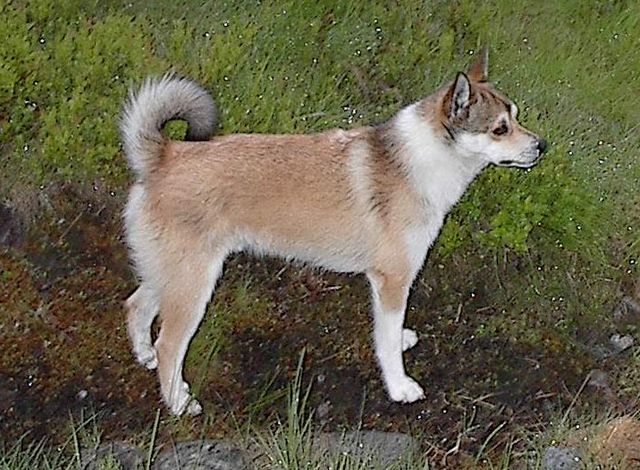The Norwegian Lundehund is an unusual little breed whose original purpose was to climb steep cliffs and grab puffin birds from nests. In order to do this job, they developed a number of unique attributes which set them apart from other breeds. For example, Lundehunds have extra toes – and lots of them! At least six toes on each foot – which means a lot of nails to trim! They are remarkably flexible and can bend completely backwards, due to joints in their neck. They can also close their ears to protect their ear canals from water and dirt. Their temperament is equally distinctive and they should be owned only by those who can handle their particular personality traits.
Lundies are happy, curious and stubborn. They are a primitive breed that have mostly evolved on their own, with only a little bit of help from humans in order to keep the breed pure. As such, they tend to act more like wild dogs than domesticated ones. They may show traits that one might find more in-line with that of a wolf or a fox than a dog (such as hiding food for later). Their curious nature means that they enjoy constant explorations of the inner recesses of your home or apartment – and there is not a lot that they can’t get into! They can climb up countertops, leap up onto most furniture or shelves, and crawl into tiny crevices. Keeping them safe from household dangers is an important concern. Outside, they might try their hand at excavating your yard.
Most Lundehunds get along great with other dogs and particularly enjoy living with other Lundehunds. As a primitive breed, it is especially important for them to figure out their “pecking order”, but once this has been decided they generally have no issues. They may have issues, however, with small pets including (and especially) birds. This has to do with their hunting history and their strong prey drive. The breed generally does well with children, but will not tolerate rough treatment from them.
When it comes to watchdog duties in the home, Lundehunds will bark to alert their owners to strangers. Although small in stature, many are protective of their own human families although they don’t normally resort to outright aggression. If they feel threatened, they will normally just keep barking. Barking is actually a common trait for Lundehunds and they do use their voices quite a lot, unlike other primitive breeds. When out in public, the breed can be reserved with people and dogs they do not know. They definitely needs plenty of early socialization from puppyhood onward. They can have a tendency to become very shy, timid and frightened of the world otherwise. If socialized, this problem is less likely to occur.
A playful breed, Lundies love toys! They particularly enjoy carrying toys (or other items) around in their mouths. Whether playing or exploring, it is important that these active little dogs are given activities in which they can use their brains. They do not thrive in homes which are sterile and uninteresting, or where they are confined to a crate for most of the day. They need regular exercise outdoors, as well as a stimulating environment indoors. If not given these things, they can become destructive in “creative” ways. After all, a dog that can burrow into your couch can also chew your couch up from the inside-out…
Training the Norwegian Lundehund is not always easy. Most do not take naturally to it, and the experience may be closer to that of training a cat! This is not to say that the breed isn’t smart – they are just incredibly stubborn and they don’t often see the point. This said, with patience (and a sense of humor) it is definitely possible. An owner is more likely to have success if they emphasize the positive (what’s in it for the dog) and keep corrections light. Housebreaking can be a particular challenge for many owners of Lundehunds, with many never becoming 100% reliable. Marking in the house (claiming territory) is another somewhat common problem with the breed. Dogs that are trained in obedience are usually much less likely to have this problem.
There is a genetic issue in the breed called Lundehund syndrome which needs to be discussed. Although every Lundehund is thought to possess this syndrome, not all are symptomatic. The condition is actually a collective term made up of several gastrointestinal disorders involving bacterial overgrowth in the intestine and protein-losing enteropathy. It is normally diagnosed when the dog is young (under a year) and there is currently no cure. The disease can sometimes be managed, but the average lifespan of an affected dog is 7-8.

Photo By Karen Elise Dahlmo
